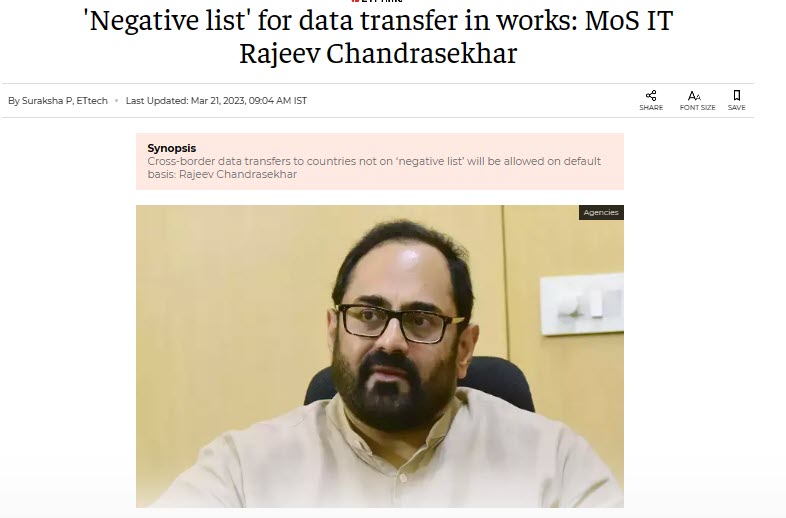In a statement which was attributed to the MOS Sri Rajeev Chandrashekar, Economic Times reported that there is a proposal to allow “Cros Border Data Flow by Default”.
Just like “Privacy By Default”, the proposal suggests “Free Data Transfer by Default”.
This proposal is fundamentally against national interests and needs to be opposed.
All of us agree that “Data is an asset of value”. It has value as raw data, as Corporate data, as personal data, as sensitive personal data, as critical personal data or even as anonymised non personal data. If these are transferrable by default it is like having a “Free Border”. Even if we declare that China and Pakistan are negative list countries, if we consider Singapore or Thailand as default transfer countries, what prevents a Chinese data buyer to target the picking up of Indian data from those countries?. How will we prevent Aadhar data or health data or Indian defence data, Scientific data etc not to be transferred freely to another country?
We had one such instance in the past when sensitive personal data of 500 million Indians were transferred by CIBIL to a US Company by change of share holding from Indian Banks to the TransUnion. This was done during the last days of Mr P Chidambaram as Finance Minister and not questioned by Mr Arun Jaitely. (Refer this article)
Any data of an Indian which is unclaimed is automatically a sovereign data. Hence all personal data are “Potential National Asset” and has to be preserved in the interest of the nation. If the data is a valuable picture or a crypto wallet number, it may have huge financial value which cannot be allowed to be transferred freely to foreign interests.
It is not surprising that Nasscom supports this view of “Free Data Transfer out of India” since for long Nasscom has been in favour of the BigTech and always thinks of the benefit to the foreign interests.
I also note some other experts such as Quantum Hub Consulting also holds views similar to Nasscom .
I also note Mr Rahul Sharma of “The Perspective” as well as Mr Vinayak Godse of DSCI seem to favour the thought of “Cross Border Personal Data Transfer by Default”.
I urge all these experts not to be swayed by the propaganda of media channels and think of what is good for the country. As long as we consider Data to be an asset of financial value, providing unregulated transfer outside India is against the economic interests of the country.
While we readily accept that EU can introduce Data Localization without calling it so and Adequacy principle without calling it a positive list, when India tries to bring in similar restrictions, there is an opposition. I donot see any logic in this. It appears more like a colonial mindset and letting foreign countries treat India as a whole as a “Data Colony”.
The earlier proposal spoke of “Data Protection Zone” like “Data Embassies”. (which was also attributed to Mr Rajeev Chandrashekar ). In this concept, each country could set up a Protected Data Processing zone to ensure that the personal data of their country when processed in India could be regulated as per their law.
We are aware that the European Nations like Portugal, France and later the East India Company started with similar permitted areas of operation and later extended to the occupation of India as a whole through deceit.
This could happen even in these Data Embassies if these embassies are not restricted to processing of personal data of their country citizens alone and not the data of Indian Citizens. This was however not intended in the proposal and hence it was hailed as an innovative measure.
The current proposition of free data transfer by default will hinder the national security since financial transactions of criminals and corrupt people will not be traceable by ED or the IT departments. MHA will not have trace of terror funding.
In view of the above, I consider that the proposal of “Free Cross Border Data Transfer by default” is anti national and has to be dropped immediately.
Otherwise opposition parties like TMC or Congress will tear into BJP in the Parliament and ensure that this Bill will be shelved once again…
Naavi







